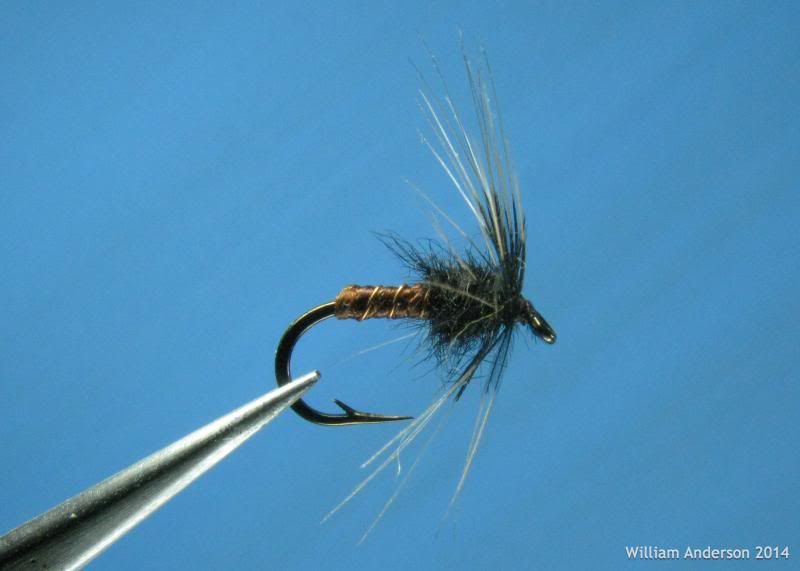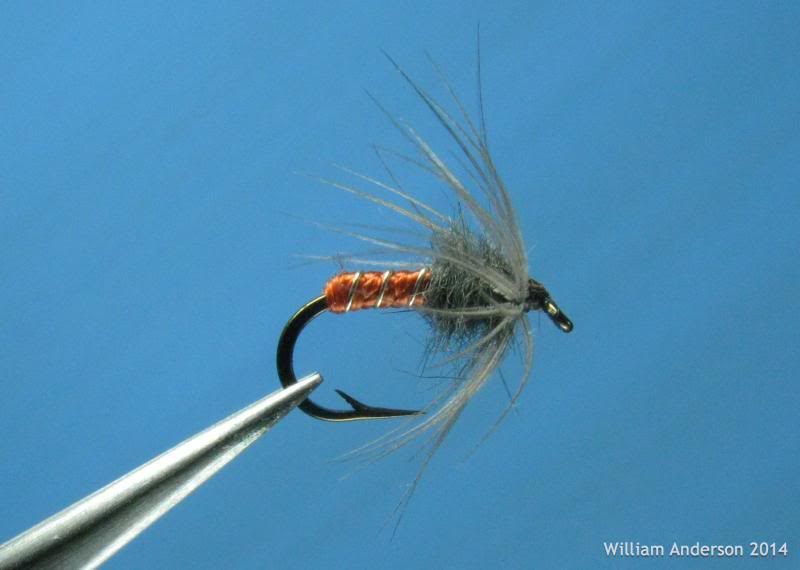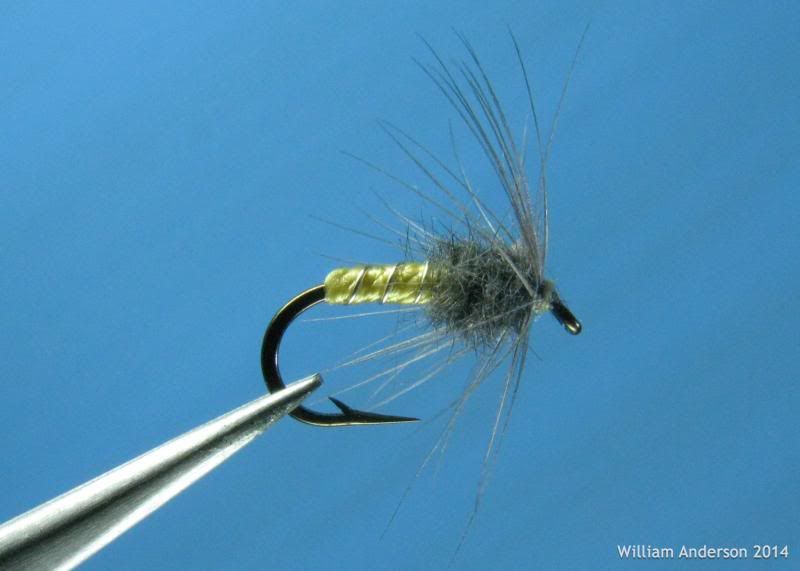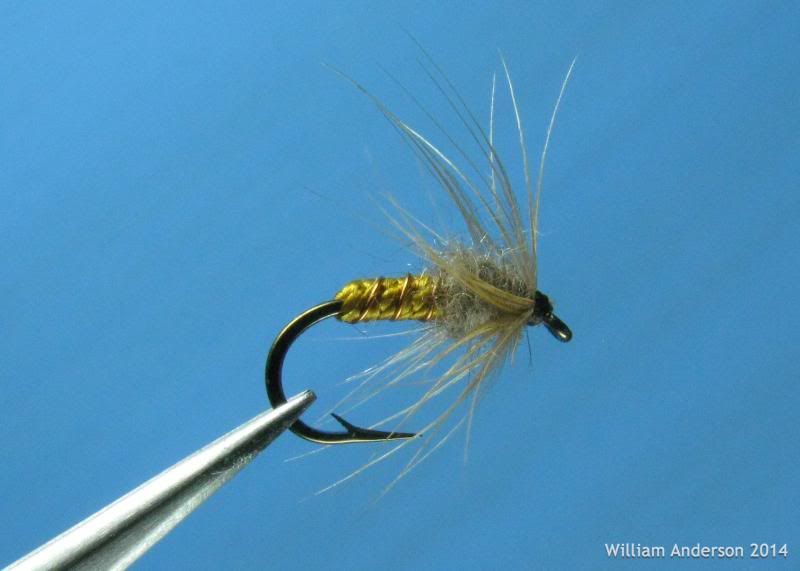Page 1 of 2
Hen, Buttonhole and Large Thorax Series
Posted: Mon Jan 13, 2014 10:22 am
by William Anderson
I was very interested and taken by the Half Stone Nymph as part of the Orphan Nymphs discussion. I noted the flies in Hidy's wallet the inclusion of several patterns tied with very robust, fine fur thoraxes. In the spirit of understanding a style of wingless wet-fly that I had not considered previously and as a way of taking the style from a remote period and to my current water, I tied up several versions that match the Half Stone construction, but like the Half Stone, seem weak in the representational dept. It's not likely intended as a stonefly, more like an emerging caddis, and as a nymph it's only slightly more plausible, but any other color combination would better represent most nymphs IMO.
I should have read this before, I forgot the content of this thread. There is great information that answers some of the questions:
http://flymphforum.com/viewtopic.php?f=5&t=5319
Please pile on with your own opinions and comments, as well as other flies that help to further the thinking behind the persistence popularity of this pattern Style. '
Here are some samples. Each tied on a Vintage Mustad 57552 #14 and Belding Corticelli Buttonhole Size D Silk.
Half Brown
Furnace hen hackle, mole thorax and buttonhole silk #5210
 Half Orange
Half Orange
Medium dun hen hackle, mole thorax and buttonhole silk #4425 (a pinkish orange color)
 Half Pale
Half Pale
Light ginger dun hen hackle, beaver thorax and buttonhole silk #5330 (a very pale tan color)
 Half Stone
Half Stone
Medium dun hen hackle, mole thorax and buttonhole silk #3030 (slightly more yellow than primrose)
 Half Golden
Half Golden
Medium ginger dun hen hackle, beaver thorax and buttonhole silk #3715 (more golden-olive than a gold thread)

Any comments of further explanation about tying and fishing flies in this construction style would be greatly appreciated.
w
Re: Hen, Buttonhole and Large Thorax Series
Posted: Mon Jan 13, 2014 1:50 pm
by Old Hat
Those are like the "prime rib" version of a North Country Spider.

I know its not much, but I'll chew on the style a bit, let it digest, then try to make more constructive observations.

Re: Hen, Buttonhole and Large Thorax Series
Posted: Mon Jan 13, 2014 5:29 pm
by daringduffer
They are meaty and offer both motion and contrast = I haven't got a clue. Maybe they belong to the "Show them something different" department. I will hurry and see if I can catch up with Carl for a chat...
dd
Re: Hen, Buttonhole and Large Thorax Series
Posted: Tue Jan 14, 2014 9:41 am
by Old Hat
I would be more convinced of stonefly if the hook was a 2 or 3x long. Then I could see some obvious possibilities. The robust bodies, the carapace of the stonefly represented by the large fur "thorax" and then the leggy hackle. My stonefly patterns are similar to this however I always wrap the hackle through the thorax area to spread the legs.
In the profile above I would be more apt to say caddis pupae. No tail, robust abdomen, a large dubbed thorax (representing the thorax and budding wings which are folded along the sides), then the hackle for legs and antennae. It sure has a more grub appearance than a stonefly appearance.
The question of merit in fishing is no doubt to me. There have certainly been plenty of times where an abnormally meaty fly is very attractive to the fish for whatever reason.
Re: Hen, Buttonhole and Large Thorax Series
Posted: Tue Jan 14, 2014 9:56 am
by tie2fish
I'm on board with Carl's caddis pupa interpretation for these chunky little beauties.
Re: Hen, Buttonhole and Large Thorax Series
Posted: Tue Jan 14, 2014 2:04 pm
by daringduffer
This is what John Roberts writes about the Half Stone in his "A Guide to River Trout Flies" where it is grouped as a West Country fly together with Blue Upright, Tup's and Infallible:
This started off as a wet fly, probably best fished as an emerging dun just below the surface or as a sedge pupa swimming to the surface. It is now more widely used as a general floater. In the same manner as the Blue Upright, a lighter-coloured version is tied with a honey-dun hackle and tail fibres. This is known as the Honey Half Stone.
A Courtney Williams writes the following in "A Dictionary of Trout Flies":
That the fly-dressers of the past did not altogether fail to appreciate the importance to anglers of the caddis pupa in the act of hatching is possible, and, indeed, probable. It is likely that some of the old wet flies were designed with this in view, the well-known Devonshire fly, the Half-stone,for example, being an excellent suggestion of the hatching insect.
dd
Re: Hen, Buttonhole and Large Thorax Series
Posted: Tue Jan 14, 2014 2:29 pm
by daringduffer
Some ideas can be extracted from here:
http://www.classicflytying.com/index.ph ... opic=40180
I am not familiar with the site, but I recognize Alex F as a knowledgeable guy from elsewhere. I would interprete his Large Dark Olive suggestion as a rather slim fly. I am unable to follow the link to the pattern tied.
Roger Woolley lists it as an "Early Olive Pattern". The fatter versions are probably a 'modern' thing.
dd
Re: Hen, Buttonhole and Large Thorax Series
Posted: Tue Jan 14, 2014 2:53 pm
by Kelly L.
They are fat little tidbits. I see your style in them, through and through. Congrats.
Re: Hen, Buttonhole and Large Thorax Series
Posted: Tue Jan 14, 2014 3:24 pm
by Old Hat
daringduffer wrote:Some ideas can be extracted from here:
http://www.classicflytying.com/index.ph ... opic=40180
I am not familiar with the site, but I recognize Alex F as a knowledgeable guy from elsewhere. I would interprete his Large Dark Olive suggestion as a rather slim fly. I am unable to follow the link to the pattern tied.
Roger Woolley lists it as an "Early Olive Pattern". The fatter versions are probably a 'modern' thing.
dd
I interpreted it Alex F's as a slim profile as well. I am registered on that site but can't get the picture to load either. I know Geert, I will see if I can get a shot of it. He is an exquisite tier.
Re: Hen, Buttonhole and Large Thorax Series
Posted: Tue Jan 14, 2014 5:34 pm
by Old Hat
Here is the photo to go along with the commentary. Geert also tied a dry in the group.

- HALFSTONEONE.jpg (199.87 KiB) Viewed 4811 times









